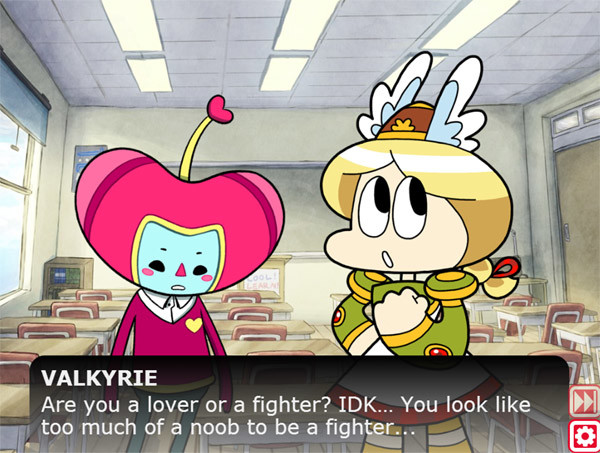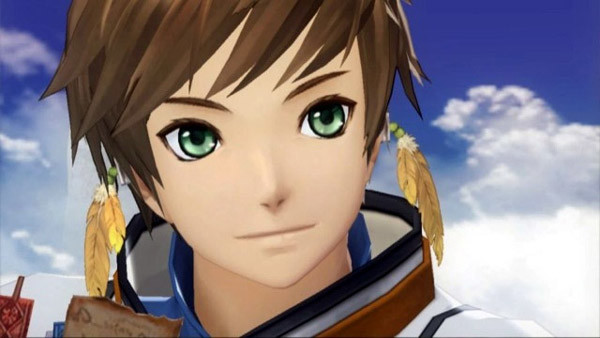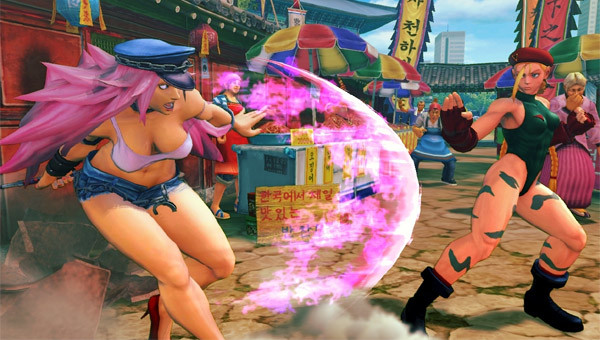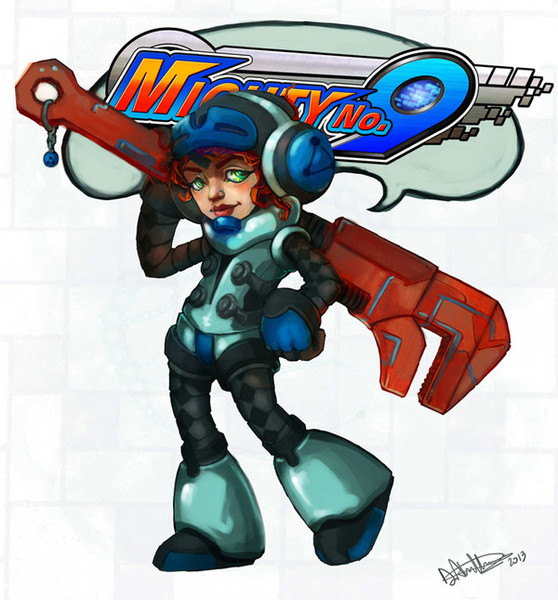- remind me tomorrow
- remind me next week
- never remind me
The X Button
Littered Picks
by Todd Ciolek,

The X Button's taking off both Christmas and New Year's, so we'll pick things up again in the first full week of January. You won't see any big retail releases scheduled in the remainder of 2013, but you might want to watch for Namco High, the browser-based dating sim full of Namco characters. In fact, I have here five codes for Namco High's extra content.

Those special-access codes will go to the first five people to answer a simple question. Namco's Valkyrie has a lizard-like sidekick named Xandra, and he earned his own side-scrolling action game on the Super Famicom. It was even translated and released in Europe! So here's the question: What is that game's European title? Send your answers to toddciolek (at) gmail.com!
[Edit: The codes are all gone! Congratulations to the winners!]
NEWS
NAMCO ANNOUNCES NEW TALES, PROVES ME WRONG
I played a little game in the week leading up to Namco's announcement of a new Tales RPG. First I evaluated the algorithmic narrative propensities of previous specimens in this franchise. Then I just guessed some slightly off-kilter fantasy names for the characters. I came up with Cyler Drandage and Kira Arceneaux, and the actual protagonist names in Tales of Zestiria are…Slay and Alicia. I wasn't even close.

Tales of Zestiria avoids the series cliché of some mysterious energy or spiritual force guiding the storyline and the society of the world. Instead, Zestiria turns to another fantasy standby: dragons. The game unfolds in the world of Greenwood, where a once-defeated dark power is rising again, and this of course affects the dragons as well as Slay (get it?). Tales producer Hideo Baba promises plenty to explore in Greenwood, and the battle system is the work of Tatsuro Udo, Tales of Graces F's combat programmer. Zestiria brings other Talesveterans aboard, including all of the character designers for the series: Mutsumi Inomata, Kosuke Fujishima, Daigo Okumura, and Minoru Iwamoto.
It may seem that Zestiria also dodges the naming conventions of the series; after Tales of Xillia, we should get a “Tales of” that isn't wearing an invented word. Well, the “zest” part of Zestiria apparently counts toward that as far as the producers of the franchise are concerned. It also keeps with the trend of Tales games sticking to Sony consoles. Zestiria is a PlayStation 3 exclusive, and it'll hit both Japan and North America.
HINTS ABOUT ULTRA STREET FIGHTER IV, BAD NEWS ABOUT MARVEL VS. CAPCOM
The recent Capcom Cup brought some new revelations about Ultra Street Fighter IV. Due out in June, the game will have a decent three-on-three battle mode that lines up players like The King of Fighters, plus an online training mode. The latter is a really neat idea for anyone who's ever wanted to learn from a better player or just practice combos with pals.

Street Fighter producer Yoshinori Ono dropped a few more hints about Ultra's mysterious fifth new character and her identity. Yes, her. As Ono's previous mentioned, the confirmed-to-be-female entrant was never before playable in a fighting game, so this rules out any crossovers from Darkstalkers or WarZard. The most plausible rumors have it that the newcomer is one of M. Bison's Dolls; not Juni or Juli from Street Fighter Alpha 3, but another cloned assassin named after a month. This would make sense from a developer's standpoint. The other new characters all come from Street Fighter X Tekken, so Hugo, Elena, Poison, and Rolento use existing models. A Doll would pretty much be Cammy's design with some new accessories. It'd be surprising and economical!
Capcom also revealed some unfortunate news about Marvel vs. Capcom 2 and Ultimate Marvel vs. Capcom 3. Both games are leaving Xbox Live and the PlayStation Network, probably due to license expiration. They're already gone from the PSN in the U.S. (European fans have until the 19th), and the last day to get them on Live will be December 26 for North America. But it's not all bad news; at this writing, both games are available on Live at heavy discounts.
SOME MIGHTY NO. 9 BACKERS GET MAD ABOUT ABSOLUTELY NOTHING
This year served up plenty of ill-reasoned fan outrage, and a frontrunner may have emerged this month. The story begins with Mighty No. 9, Keiji Inafune's Kickstartered rebirth of Mega Man. When the project was still in development, backer Dina Abou Karam posted suggestions about making main character Beck's partner Call playable (which happened), plus fan art of a female Beck (below). Months later, Karam was hired as the community manager and one of the designers for Mighty No. 9, and certain fans let accusations fly: she got the job through her boyfriend, she wanted to inject the game with that dreaded feminist agenda, and, according to some old Twitter posts, she wasn't that much of a Mega Man fan!

It's all just another case of sexist fans working themselves into a panic over vague threats to male-centric narrative. Allegations of favoritism seem downright naïve to anyone who's ever gotten a job through knowing someone (which is most of us), and it's hilarious to see fans so bothered by the mere suggestion of sexual equality in their revival of Mega Man, a series that could really use more female characters in general. It's not so hilarious that some creeps are demanding and getting refunds, apparently disappointed with a game that they haven't seen in any finished capacity. Allegations of Karam not being a true Mega Man fan are similarly odd; even assuming she didn't care about the series before now, she could school herself in all of the major games over a weekend. C'mon, folks. Let's try to end this year well.
THE TOP FIVE OVERLOOKED GAMES OF 2013
You can make excuses when the world neglects a game you enjoy. It was poorly marketed. It was a niche title. It was a work of artistry too complex and challenging for plebian minds to appreciate. However, it's much better just to talk up that game whenever you can, focusing more on its good qualities than the ways in which the market wronged it. I can't let go of bitterness, of course, so I take both routes when it comes to my favorite lesser-known games of the year.
5. RUNE FACTORY 4 Rune Factory 4 did well in some ways. Publisher Marvelous reported that it sold better than any previous Rune Factory, after all. Yet that still wasn't enough to make Rune Factory a major player in RPG circles, and it wasn't enough to keep afloat its developer, Neverland Company. I already spent one column on an embarrassingly long eulogy for Neverland, but Rune Factory 4 demands praise on its own.
Rune Factory 4 did well in some ways. Publisher Marvelous reported that it sold better than any previous Rune Factory, after all. Yet that still wasn't enough to make Rune Factory a major player in RPG circles, and it wasn't enough to keep afloat its developer, Neverland Company. I already spent one column on an embarrassingly long eulogy for Neverland, but Rune Factory 4 demands praise on its own.The Rune Factory series seems an excellent idea: take the farming and small-scale mercantilism of the Harvest Moon games and throw in a lightweight action-RPG. The earliest Rune Factories struggled with this recipe, but Neverland eventually got it right. Rune Factory 4 has a more sedate tone than its immediate predecessor (which cast the hero as a were-sheep of sorts), and it's entirely captivating. The player-named hero or heroine is in charge of a kingdom's day-to-day workings, from the crops to the medieval-fantasy zoning laws, and there's a wealth of characters to befriend and, in some cases, romance. Actually, you can tell just about any townsperson that you love them, which alone is enough to recommend Rune Factory 4. Beyond that, Rune Factory 4 is the rare sort of game with an unhurried appeal. The demands of state are many, but they're rarely drawn out. Neverland streamlined the farming and dungeon-diving into a smooth flow, and it makes the game's triumphs all the more important, whether it's the simple joy of a profitable crop or the long-term rewards of starting a family. Rune Factory satisfies in places other games seldom go, and it makes one hell of a finale for Neverland. Lookalikes: Forte, the kingdom's dutiful and secretly candy-obsessed guardswoman, looks a bit like Saber from the Fate/Noun franchise, right down to the half-armored dress.
|
4. THE WONDERFUL 101 The Wii U has its struggles: low sales, a limited catalog, and the pessimistic perception that it's just a Wii with a tablet-controller and prettier video quality. But the Wii U also has Platinum The Wonderful 101, and that matters a lot. Well, it should matter, at least. In better times a game like The Wonderful 101 would sell systems, but this is not the age we know.
The Wii U has its struggles: low sales, a limited catalog, and the pessimistic perception that it's just a Wii with a tablet-controller and prettier video quality. But the Wii U also has Platinum The Wonderful 101, and that matters a lot. Well, it should matter, at least. In better times a game like The Wonderful 101 would sell systems, but this is not the age we know. Platinum traffics in comic-book stories much of the time, whether it's the overt macho violence of Anarchy Reigns or the stranger sleaze of Bayonetta. The Wonderful 101 is a brighter tokusatsu take on the superhero concept, a Pixar-esque recast of the Viewtiful Joe standards that director Hideki Kamiya polished up while at Capcom. Players start with a single superhero named Wonder Red and a mass of fearful citizens, all caught in an alien invasion. From there the player gathers up other stereotyped heroes and average people, racing around like groups of Pikmin in a city under attack. Together, they form fists, swords, hammers, and all sorts of other weapons. It's the stuff of cartoons that teach kids all about teamwork and believing in yourself, but it's wrapped up in an action game like no other. Players sculpt their superhero teams into shapes through the Wii U's tablet, making good use of the oft-derided device, and it benefits further from Kamiya's characteristically accomplished level design and grandiose boss battles. Mario and Zelda may provide many ways to show off the Wii U, but only The Wonderful 101 does it with something entirely new. Lookalikes: As an immense tribute to superheroes, The Wonderful 101 traffics in all sorts of archetypes and references, from Wonder White's Vega-like claws to the Geathjerk commanders, all of whom could've stepped out of any modern Kamen Rider show. |
3. SWEET FUSE Former Mega Man caretaker Keiji Inafune went many places after leaving Capcom: the twisted medieval horrors of Soul Sacrifice, the short-lived superhero action of J.J. Rockets, and the undisguised Mega Man revival of Mighty No. 9. Yet his strangest role is in Sweet Fuse. He's the uncle of the protagonist, Saki, and she's on hand when a creature named Count Hogstein kidnaps Inafune and takes over his amusement park. No, there is no Inafune-run theme park in real life. Sweet Fuse is a fantasy on a number of levels.
Former Mega Man caretaker Keiji Inafune went many places after leaving Capcom: the twisted medieval horrors of Soul Sacrifice, the short-lived superhero action of J.J. Rockets, and the undisguised Mega Man revival of Mighty No. 9. Yet his strangest role is in Sweet Fuse. He's the uncle of the protagonist, Saki, and she's on hand when a creature named Count Hogstein kidnaps Inafune and takes over his amusement park. No, there is no Inafune-run theme park in real life. Sweet Fuse is a fantasy on a number of levels.Inafune may set up the show, but Sweet Fuse is really about Saki and the six gorgeous men trapped with her by Hogstein's cruel machinations. They meet all the quotas of typical "otome" games: police inspector Subaru is the efficient and overprotective type, Towa's an earnest and semi-spoiled pop star, Kouta's a withdrawn game-geek in a faux straitjacket, and so on. As with the better visual novels, all of them rise a touch above their stereotypes, and the storyline shifts to different paths as Saki grows closer to her assortment of allies. It helps that Saki is far from a wilting, largely unseen main character built solely for the player's identification. Even though she must depend on her comrades from time to time, she's outspoken and strong-willed throughout the whole experience. Visual novels still stalk about the margins of North America's game industry. Some blame their reliance on text and still images, and others point to the genre's association with risqué virtual girlfriends and whatnot. Yet even if you disdain visual novels, Sweet Fuse might be the one to crack your resistance. Lookalikes: Most of Sweet Fuse's cast fit the mold of characters from Hakuoki and other otome games. And hey, that Keiji Inafune guy looks a lot like Mighty No. 9 producer Keiji Inafune! What a coincidence!
|
2. PANDORA'S TOWER North America was lucky to get Pandora's Tower. Ganbarion's grim, inventive action game was nearly two years old by 2013, and just about everyone had given up on Wii releases in favor of the Wii U. Yet XSEED squeaked out Pandora's Tower as the last major Wii title on these shores, and it couldn't hope for more than a limited audience.
North America was lucky to get Pandora's Tower. Ganbarion's grim, inventive action game was nearly two years old by 2013, and just about everyone had given up on Wii releases in favor of the Wii U. Yet XSEED squeaked out Pandora's Tower as the last major Wii title on these shores, and it couldn't hope for more than a limited audience. Pandora's Tower is a surprising turn for a developer known previously for One Piece games and other anime by-products. It's a love story, yes, but it pivots around a gruesome fantasy. Elena's cursed with monstrous mutations during a city festival, so she and her boyfriend Aeron head out to the only place a cure might lie: towers suspended above a hellish chasm in the middle of nowhere. Aeron raids the towers for monster flesh, which Elena must consume to keep herself human and sane. The two halves of Pandora's Tower are marginally impressive on their own. The towers play out like a faster-paced Zelda, with Aeron's grappling chain and swords providing most of the solutions to puzzles. Aeron and Elena's relationship has shallow overtures, and Elena's voice actress frays the emotional impact a bit. Yet it mixes well. Pandora's Tower runs a precarious balancing act, as exploring the towers and uncovering their secrets all ties into Elena's deterioration. Each completed stage yields some hints of a darker story, and there's more to Elena and Aeron's interplay than an abbreviated dating simulator. It's the sort of oddity that would fall between the gaps anywhere in the market: too harsh for younger players, too offbeat for the older mainstream. With any luck, Pandora Tower's will snare a cult following in the years to come—and perhaps Ganbarion will get the chance at another experiment like this. Lookalikes: Minor controversy stirred over Aeron and Elena having haircuts similar to Noctis from Final Fantasy XV. Fortunately for Pandora's Tower, no one will remember this by the time Final Fantasy XV comes out.
|
|
1. ATTACK OF THE FRIDAY MONSTERS: A TOKYO TALE Attack of the Friday Monsters is all about childhood. A lot of games are about childhood in abstract manners, but Kaz Ayabe traffics in nostalgia more efficiently than just about any other director in the industry. His Boku no Natsuyasumi series evokes the carefree diversions of youth in pastoral surroundings, and it's much the same way in Attack of the Friday Monsters. It's a game about that fleeting summertime haze when you were old enough to appreciate giant monsters but young enough to believe they just might be real.
 Sohta's the new kid in Fuji no Hana, a little Tokyo outlier where titanic creatures do battle on Friday and the populace treats it like a regularly scheduled rainstorm. Sohta scurries around town, lending an ear to his young friends, talkative shopkeepers, creatively tapped TV producers, and strange personalities. It's a game about children but not necessarily for children, scrutinizing little samples of the adult world through the unintentionally candid gaze of a kid. Some find it a problem that Attack of the Friday Monsters dips into that other hallmark of childhood: collecting and trading some craftily marketed toy. Sohta collects Monster Glims and puts them to use in adorably serious battles with his playmates, but the game stalls a bit when it comes to gathering decks of Monster Cards. But isn't that part of childhood? Putting time into some shallow pastime mostly because everyone else is? Perhaps that's the best thing about Attack of the Friday Monsters. It may make us relive a summer as a ten-year-old, but it also makes us glad that we've grown past it. Lookalikes: The monsters of the title are stand-ins for the Godzillas and Ultramans of the 1970s, doctored just enough to remind you of the rip-off characters you devised in your youth. |
The Darkstalkers series burned bright and brief. There was a moment in the late 1990s when the series eclipsed Street Fighter in popularity, but only for Japanese fans and only until Street Fighter III got its act together. Darkstalkers deserved a comeback. It's a delightful fighting-game adaptation of classic monsters, and the animation is downright remarkable. Characters squash and stretch into different forms and show off sorts of little details: catgirl Felicia nabbing bugs out of the air, B.B. Hood sobbing over her grandmother, zombie rocker Lord Raptor bouncing and dunking his opponents in basketball form…it's the rare game that's nearly as fun to watch as it is to play. Not that it slouches in gameplay, either.

Sadly, Darkstalkers Resurrection didn't catch on to Capcom's satisfaction. It's a superb repackaging of the two best games in the series, with various ways to tweak them. They're still pretty and playable fighters, sporting a slightly looser, more cartoonish treatment of Street Fighter's six attack buttons and combos. But Darkstalkers isn't as popular as Street Fighter or the various Marvel fighters, and it seems that Resurrection was its only shot at the modern era. You'll see Morrigan and Felicia and a few other characters in crossover games, but you'll never see them in a brand new Darkstalkers.
Lookalikes: Darkstalkers began life as a fighting game based on Universal monsters, so all of the original characters have their movie analogues (except Felicia, but cat-women are nothing new). That's all part of the charm, and Darkstalkers fans can make themselves sick imagining how other creatures of myth and cinema would look in a sumptuously rendered Capcom fighter. In the spirit of the holidays, I'd go with an anime-style Krampus who throws wicked children at his foes.
NEXT WEEK'S LACK OF RELEASES
Yes, there's nothing headed our way next week or the week after that. Those are the breaks at the end of the year. But there's plenty coming in 2014, and there's plenty to play that came out in 2013. And what were your personal favorites of this year? Let's hear your picks! Unless you'd care to argue about Darkstalkers instead. I'm always a fan of that.
discuss this in the forum (51 posts) |
this article has been modified since it was originally posted; see change history